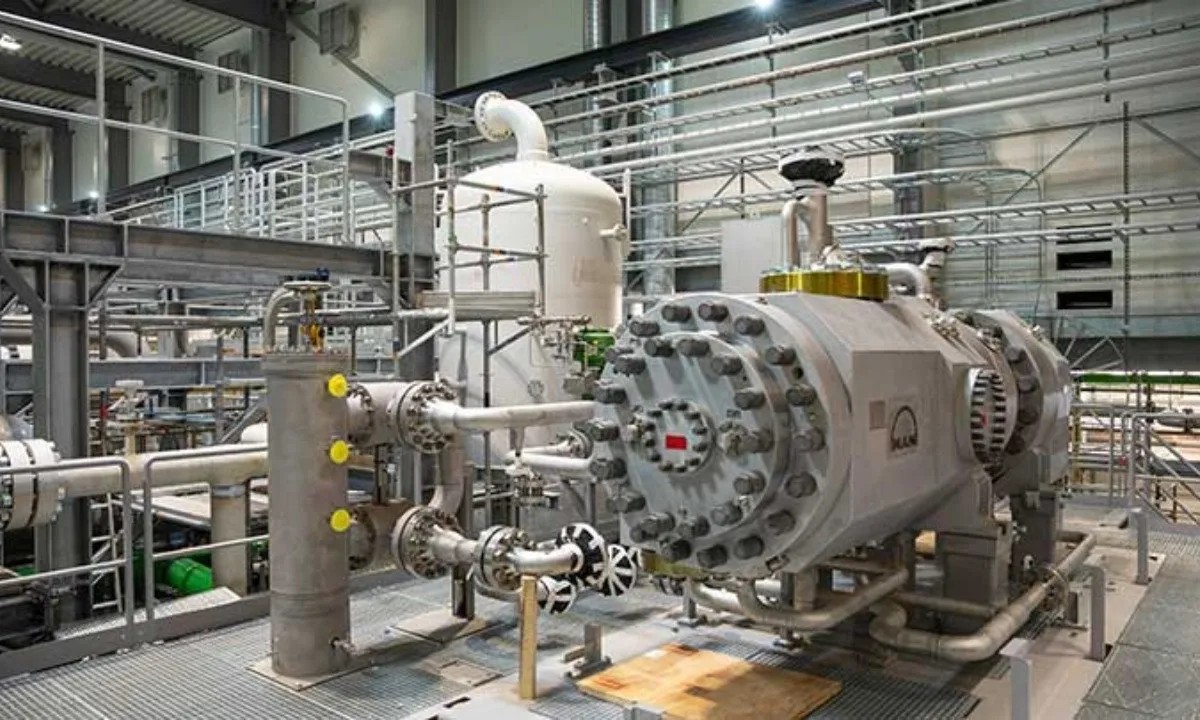Danish utility poised to supply 60MW of zero-emissions district heating with MAN’s CO2 heat pumps
June 16, 2023

The Danish utility company DIN Forsyning is poised to supply the seaport town of Esbjerg, Denmark, with zero-emissions district heating by using two industrial-sized CO2 (R744) heat pumps from MAN Energy Solutions that are powered by offshore wind farms and heat from the Wadden Sea.
The heat pumps, with a heating capacity of 60MW (17,061TR), are called Energy Solutions CO2 Electro-Thermal Energy Storage (ETES) Heat Pumps.
“We’re phasing out coal-fired heat and replacing it with carbon-neutral district heating produced from wind and seawater,” said Kenneth Jørgensen, Project Director at DIN Forsyning. “The switch will save about 120,000 [metric] tons of CO2e emissions a year,” which supports Esbjerg’s plans to decarbonize by 2030.
As part of the turnkey solution, MAN, Headquartered in Augsburg, Germany, built and tested the ETES water-to-water heat pumps at its production hall in Zurich, Switzerland.
Both the seawater system and the district heating system are commissioned and ready for service, Jørgensen said, adding that the mechanical installation is almost complete and will start operating in the fall.
Dubbed “the world’s largest supercritical heat pump” system in an article on MAN’s website, the units supply heating for the city’s population of 100,000 – roughly 25,000 households. “It is the first of its kind to provide thermal energy – that is, the transfer of heat – on a major industrial scale.”
“The plant is like a reverse air conditioner,” said Karl Böhle, MAN’s Senior Project Manager. However, instead of cooling a building, the system uses renewable electricity to extract heat from seawater and multiply it for distribution. This is a decarbonization solution that can be used for industrial processes worldwide, Böhle added.
Seawater, drawn from the harbor at 4,000l (1,057gal) per second, arrives in large gray tubes, where the thermal energy in the seawater evaporates CO2 before returning to the sea.
Using electricity generated by offshore wind farms, the vaporized CO2 is compressed to temperatures high enough to boil water. A heat exchanger transfers the CO2 heat to water, which leaves the facility in green tubes to be pumped through the existing underground district heating network. The CO2 process loop of compression and expansion happens at pressures over 150bar (2,176psi).
“The specialty of the system we’re installing is that we’re using seawater as a heat source, CO2 as a refrigerant and a hermetically-sealed, electrically driven compressor to generate heat,” Böhle said.
Located next to the Wadden Sea, which is a UNESCO World Heritage Site and National Park, the utility requires a non-toxic and safe-working fluid with high heat capacity. For these reasons, the utility chose a CO2 system over an ammonia (R717) or synthetic one. “If [CO2] leaks, it would just go into the carbon cycle of the sea,” said Jørgensen.
Balancing the grid
It was very important to the utility to provide a balancing service to the electrical grid, noted Jørgensen.
To that end, the high-speed electrical motor driving the heat pumps can “quickly” ramp up or down electrical consumption, Jørgensen said; this accommodates the need for the system to adjust to the sudden changes in the green electrical production associated with wind turbines and solar panels.
This design balances the electrical grid by “taking excess electricity when it is in the grid and converting it to [storable] heat to send out to our customers at another point in time,” Jørgensen said. Unlike an electrical grid, the heat pump’s production does not have to match its consumption.
Claus Nielsen, Business Development Director at DIN Forsyning, finds the flexibility of the ETES system very attractive, citing its ability to use various electrical sources if wind power is unavailable and its ability to deliver both high and low temperatures for district heating and cooling, as needed. In addition, the turbo-compressor technology allows DIN Forsyning to earn revenue from supplying stabilization services to the electrical grid.
Situated on the coast of southwestern Jutland, Esbjerg regularly experiences temperatures below freezing from November to March.
Operating for more than 250 years, MAN offers energy, maritime and gas and oil technology solutions. In 2018, the global company changed its name from MAN Diesel and Turbo to MAN Energy Solutions as part of its focus to support the transition to a carbon-neutral future.
“Back in 2018, we were marketing ETES as an electro-thermal energy storage solution for storing energy as heat and cold that could be reconverted to reproduce electricity,” said Raymond Decorvet, Global Business Development ETES at MAN. Once MAN became aware of DIN Forsyning’s call for tenders, the company realized the ETES was “ideally” suited to supply district heat for Esbjerg residents.


